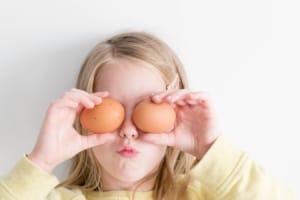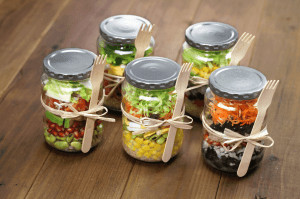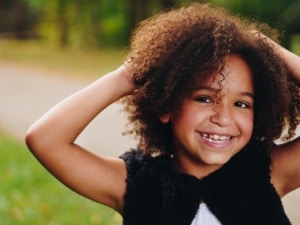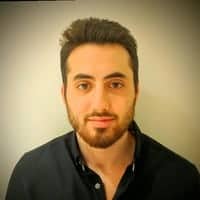Children’s Hair Care: Natural Kids Shampoo & More!

The word “natural” can mean different things, depending on who you’re asking. The FDA considers the term to be of great importance when discussing food, for example, but of far lesser significance when it comes to skin and hair care products. As a result, the word “natural” is used a lot more liberally in the cosmetics industry. This means that it is on us, the end consumers, to be the judge in many cases.
Shampoos meant for kids (unlike those meant for babies) are not very different from adult shampoos. Sometimes a kids shampoo is literally a diluted or otherwise reduced-strength version of a certain brand’s ordinary shampoo. Despite the similarities, the subtle differences can be highly instrumental in keeping your kid’s scalp and hair healthy.
A shampoo’s primary function is to clean the scalp of dirt, oil, and other buildup. As long as it gets this done without harming the hair and skin, it’s doing its job. Anything else that the shampoo may do is secondary. In that regard, a children’s shampoo is not seen as a real necessity, unlike baby shampoo.
Hair Vitamins For Kids Explained

Eggs are good source of protein for hair.
Just like their adult counterparts, hair vitamins for kids are not a serious necessity. Those experiencing a deficiency in certain vitamins or nutrients could find those supplements to be beneficial, but they are not an essential part of ongoing hair care. Taking vitamin supplements is not the go-to solution for hair care, whichever way you look at it. There are other ways to acquire said vitamins, but supplements are a quick and easy way to guarantee your body is getting what it needs in order to (also) grow healthy hair.
The question remains the same, just as it does with adults: are these vitamins doing their job? Hair growth is something the body does naturally, but it’s not essential for sustaining life. As such, any vitamins introduced to a person’s system – particularly ones in which they are deficient – will first be put to use in areas where they are needed more. Hair is not high on the list of priorities, since it is not vital.
The most sought after vitamin in connection with hair growth is biotin. Formerly known as vitamin H and vitamin B7, biotin is a vitamin that helps the body produce energy. It also plays a role in the growth and health of hair, skin, and nails.
Natural Hair Products For Kids
Some of the companies which make natural hair care products for adults also make versions for kids. They’re usually less intense, but still made of the same types of ingredients. There is no specific age where kids ought to switch to an “adult formula” product. However, if there is any question consult with your child’s physician. Childhood hair has a tendency to be softer and more dense. Likewise, a child’s scalp will often exhibit different characteristics than an adult’s scalp, and be more sensitive and susceptible to outside influences in general.
Because of these differences in the hair and scalp, natural hair products for kids are available alongside the adult ones. These products are not always a necessity, but it’s nice to have the option of a kid-friendly version. Products which contain essential oils, for example, could have a different effect on children as opposed to adults, because children are more sensitive, overall. Due to this, some essential oils are not recommended for kids below a certain age.
Adults and kids alike can benefit from natural ingredients in their hair routine. The mainstream commercial hair care products have their place, it’s not as though they are useless. But if you are interested in providing your kids’ hair and scalp with more nourishing ingredients – which are less likely to cause issues in the short and long term – natural is the way to go.
Dandruff Shampoo For Kids

Kids hair.
Dandruff is brought on by a normal and natural process: the skin cycle. We all shed dead skin cells from the scalp, along with dead skin from the rest of the surface areas of our body. Normally, (unless the skin is affected by some condition or disease) those dead cells are not visible to us as they are shedding. This is precisely what acute or chronic dandruff is: visible shedding, as opposed to invisible.
Dead skin which is white or yellow, coming in overly-flake or scaly – this is what we consider to be problematic dandruff, and it can range from mild to severe. Kids and adults alike suffer from dandruff, although some are more prone to it than others. Using shampoos that contain natural plant extracts like tea tree oil or eucalyptus oil can be beneficial for such cases. Hair care products for kids which target dandruff will often contain decreased amounts of the ingredients found in the adult versions of those shampoos.
Like other shampoos, this is not a one-size-fits-all type of situation. What works for one kid may not work for the other. A big part of dandruff is the prevention aspect. Bringing the scalp to balance of sebum and pH levels can be achieved with proper care. Then, once the scalp is clean, it is all about prevention. Dandruff can be affected by diet, mood, hormones, physical activity (or lack of it), and various glandular issues in the body.
Dry Scalp Shampoo For Kids
Dandruff is closely associated with a dry and/or itchy scalp. Depending on the type of dandruff in question, the scalp could be exceedingly dry. Dry and brittle hair strands are often the result of a malnourished scalp. Dry scalp shampoos for kids attempt to replenish moisture and retain the scalp and roots’ vitality.
Using a conditioner and keeping the scalp hydrated in the long-term – this is also a big part of the solution. Ideally, a good dry scalp shampoo will be one that manages to clean the scalp and roots without drying them further. Even without a conditioner, you could use a shampoo which provides moisture and keeps the scalp clean. A dry scalp shampoo, whether for kids or adults, often comes with ingredients that won’t worsen the condition of the scalp.
A dry scalp can be itchy and uncomfortable, even without any dandruff present. The dryness and lack of hydration can irritate and even cause pain. Once you start providing the scalp with what it needs, it will be able to address the issues relating to oil and debris, and also take care of the hair roots. Dryness will usually go away on its own when the scalp finds its balance, and these shampoos are geared towards that goal. Even so, take care not to over wash, as this could bring with it adverse effects.
Why Do Kids Get Lice?

Kids in close contact.
The most obvious and general answer to the question of “why do kids get lice?”, is that their heads are closer in proximity to each other significantly more than in the adult world. Kids tend to get lice more than adults. Nevertheless, the condition exists and persists in both populations, and in relatively high numbers.
Adults rarely put their heads together in the same ways that kids do during play, studies, etc. Kids who have lice are usually not dirtier or less cared-for than others. Head lice are wingless, but they can jump very far. This is mostly how they get around, and it doesn’t mean that an infested child has poor hygiene habits. Even the most pristine and cleanest of children can easily contract head lice.
Close contact with an infested head is the most common way of acquiring the condition, but not the only one. If you share hats, scarves, or other articles of clothing that may have come into contact with an infested individual – it could also show up that way. Likewise, sharing hair ties, combs, brushes, and hair accessories at large is a way to become infested, regardless of your hygiene practices.
Lice Shampoo For Kids
Lice shampoo comes in two main varieties: ones for treatment and others for prevention. These specific shampoos can help kill the lice, and also keep them from re-infesting the scalp. You can buy some products over-the-counter, while others require a doctor’s prescription. Medicated lotions and creams for topical application may be prescribed by a physician in cases where the lice have adapted to the over-the-counter treatments, and are resistant to them.
The ordinary non-prescription shampoos are often non-toxic, and are made from natural ingredients which kill or prevent the ongoing infestation. Be sure that if you are using some type of DIY method, you take absolute care to keep from harm. Plant extracts like essential oils can be seriously strong and potent to the point of detriment, if misused.
Make sure to follow any instructions that are on the label of your commercial products. Using too much or too little may cause it to be ineffective. There is often a cycle of repetition, with a second shampoo treatment being scheduled in order to kill the eggs which had not yet hatched at the time of the initial treatment.
If the shampoo you are using is proving to be ineffective following treatment, consult a pediatrician. In some severe cases, ordinary topical treatment is ruled out, and an antiparasitic drug is prescribed in its stead.
Natural Hair Growth For Kids

Healthy diet for hair growth.
Dieting is a big part of what helps hair grow, and this is true for kids as much as it is for adults. If you’re interested in helping your child’s hair along during its growing phase, certain foods can be a great way to get that done.
Please note, if there is too much shedding and/or bald spots, rashes, excessive dryness or highly noticeable dandruff, etc, – you should consult with your kid’s pediatrician. Adding certain foods to your kid’s diet may help hair growth, but not if the lack is due to a primary or otherwise-underlying condition.
Kids can benefit from foods that have vitamin E, such as peanuts, corn, avocado, broccoli, and spinach. Vitamin E encourages a healthier scalp, and its natural antioxidant properties are useful for keeping hair follicles and strands from becoming damaged.
Foods such as citrus fruit, peas, beans, nuts, and poultry are high in folic acid. This acid helps to promote the healthy and strong development of hair strands. It’s true that the main health of a hair is at the root. Nonetheless, keeping the strands vital and nourished is also of the utmost importance, if you’re after good-looking hair.
Vitamin B is essential for protein production, and the hair strands are simply strings of protein. Eating foods high in B-complex vitamins, such as eggs, fish, almonds, whole grains, berries, and bananas, may contribute to proper hair growth.
On the whole, dairy products were seen as a contributor to a healthy system, including hair growth. Make sure you’re getting enough calcium from non-dairy sources as well, since dairy may not be all it is cracked up to be.
Finally, water – pure, simple, natural, dihydrogen monoxide. Hydration is key in keeping the body in that healthy equilibrium known as homeostasis. This translates into a happier and more growth-oriented body in general. Keep the body’s different systems running optimally, by getting enough water every single day.
Curly Kids Hair Care Tips

Girl with curls.
Curly hair can be a pain in the neck, whether you’re a kid, an adult, or anything in between. It can be a challenge, due to the fact that with hair which coils, twists around, or zig-zags is difficult to manage sebum reach. Sebum is a big part of natural hair maintenance. With curls, there might be additional maintenance that needs to be carried out in order to avoid tangles and dryness.
As for kids, the best tips start with washing. Use a shampoo that won’t dry up the scalp and hair. Getting the scalp clean is a shampoo’s main objective. Just don’t do it too often or else you run the risk of drying it out.
Depending on the child’s hair type, they may require more conditioner than shampoo. Literally, you should apply the amount in larger quantities. The scalp may be clean, but the hair itself could still be in dire need of moisture. Conditioning once a week is the norm, but if you see or perceive excessive dryness, consider conditioning twice a week for a trial period.
Shampoo and condition as needed, but try to avoid other types of products when you can. Don’t weigh your kid’s hair down with all kinds of (sometimes) unnecessary additions. Make an attempt to use relatively mild hair care products. Kids are more sensitive in general, and the aforementioned differences between a child’s scalp and hair, and an adult’s scalp and hair, could definitely be present here as well.
Use a brush or comb which is formulated specifically for curly kids. Ones which will manage to remove dead hairs and whatnot, without breaking or damaging the hair. A wide-tooth comb is usually recommended for curls, but it could vary from one case to the next.
Grey Hair In Kids Explained
Greying hair carries a certain element of respectful aging with it. In the last decade or so the grey hair trend (aka Granny Grey) has made greying hair popular again, for naturals and dyed greys alike. But when it comes to kids, it can be a whole other kind of situation, quite unrelated to fashion (to say the least).
First off, if it’s one or two hairs there probably isn’t anything to worry about. If you are concerned, speak to your child’s doctor. Now, if the problem persists and the grey hairs spread – then you should definitely see a doctor, since this could be a symptom of an underlying issue.
Technically speaking, the cause of grey/white hairs in adults and kids is one and the same – the body stops producing the melanin which pigments the hair. That’s the technical reasoning behind it. As for the catalyst? It could be any one of several things such as genetics, unbalanced diet and/or nutrient deficiencies. It could also be a separate medical issue like a disease of some kind, stress and/or depression, and even overuse of damaging hair care products.
There is no treatment for this kind of condition. The answer will invariably be ruling out different causes until you zero in on the problem. Then it becomes a matter of contending with the issue which is causing the appearance of grey hairs, be it a deficiency, syndrome, illness, etc.
Hair Oil For Kids Breakdown

Using oil on hair.
Hair oil is one of the most nourishing things in the known universe. It doesn’t have to be oil which is specifically formulated for hair care, by the way. It can be straight-up coconut oil, for example, which can technically be used in many other ways. You don’t need to invest in an expensive product geared towards hair, unless that’s your desire.
A children’s scalp tends to have less sebum production going on. The hairs themselves have a tendency to be softer and at times noticeably weaker. The hair strands’ vitality could definitely use some boosting. Using natural oils (essential and carrier oils) is one way to infuse the scalp and hair with nutrients and moisture.
I mentioned coconut oil, which is quite popular, and then there are also olive oil and argan oil, both of which are used extensively in hair care products meant for adults. Jojoba oil and almond oil are two which greatly resemble the sebum. They can provide a lot of help in hair maintenance and management. The idea is roughly the same with all of these: take some oil, massage it gently into the scalp using your fingers, and let it sit for 15 to 20 minutes before combing it through the strands, and then follow that up with shampooing it out.
As for application on wet or dry hair, and interaction with other oils and products – it depends on your choice of oil. Do your research, see what works best for your kid’s hair, and err on the side of caution. As always, if there are any adverse effects, sensitivities, signs of potential allergic reaction, etc., discontinue use and consult a health care professional before resuming treatment.
Conclusion
Studies and research into the various FDA-approved detergents and preservatives commonly found in cosmetics are still ongoing. The debate is still all over the place. Opinions range from “stay away from it all, it’ll make you ill!” all the way to “come on, a little sulfates and parabens never hurt anyone”.
If you are looking to avoid this controversy to begin with, natural ingredients are one way to do that. With natural ingredients, you often get what your hair needs, and none of what it doesn’t. You can say the same for DIY products. Hair care solutions which don’t contain high amounts of potentially-harmful chemicals can be gentler on children’s scalp and hair, and safer overall.
Not every product that has “natural” on its label is something you should consider putting on your kid’s hair. You can find natural kids shampoos all along the respective spectrums of price and efficacy. Not everyone will be content with a gentler and natural shampoo, and will instead insist on the rougher over-the-counter stuff. Some kids, who may be a lot more active, sweaty, and generally more prone to debris accumulation, could require significantly higher degrees of attention in order to keep the scalp and hair clean.

